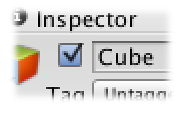Deactivating GameObjects
A GameObject can be temporarily removed from the scene by marking it as inactive. This can be done using its activeSelf property from a script or with the activation checkbox in the inspector

A GameObject’s activation checkbox
Effect of deactivating a parent GameObject
When a parent object is deactivated, the deactivation also overrides the activeSelf setting on all its child objects, so the whole hierarchy from the parent down is made inactive. Note that this does not change the value of the activeSelf property on the child objects, so they will return to their original state once the parent is reactivated. This means that you can’t determine whether or not a child object is currently active in the scene by reading its activeSelf property. Instead, you should use the activeInHierarchy property, which takes the overriding effect of the parent into account.
This overriding behaviour was introduced in Unity 4.0. In earlier versions, there was a function called SetActiveRecursively which could be used to activate or deactivate the children of a given parent object. However, this function worked differently in that the activation setting of each child object was changed - the whole hierarchy could be switched off and on but the child objects had no way to “remember” the state they were originally in. To avoid breaking legacy code, SetActiveRecursively has been kept in the API for 4.0 but its use is not recommended and it may be removed in the future. In the unusual case where you actually want the children’s activeSelf settings to be changed, you can use code like the following:-
// JavaScript
function DeactivateChildren(g: GameObject, a: boolean) {
g.activeSelf = a;
for (var child: Transform in g.transform) {
DeactivateChildren(child.gameObject, a);
}
}
// C#
void DeactivateChildren(GameObject g, bool a) {
g.activeSelf = a;
foreach (Transform child in g.transform) {
DeactivateChildren(child.gameObject, a);
}
}